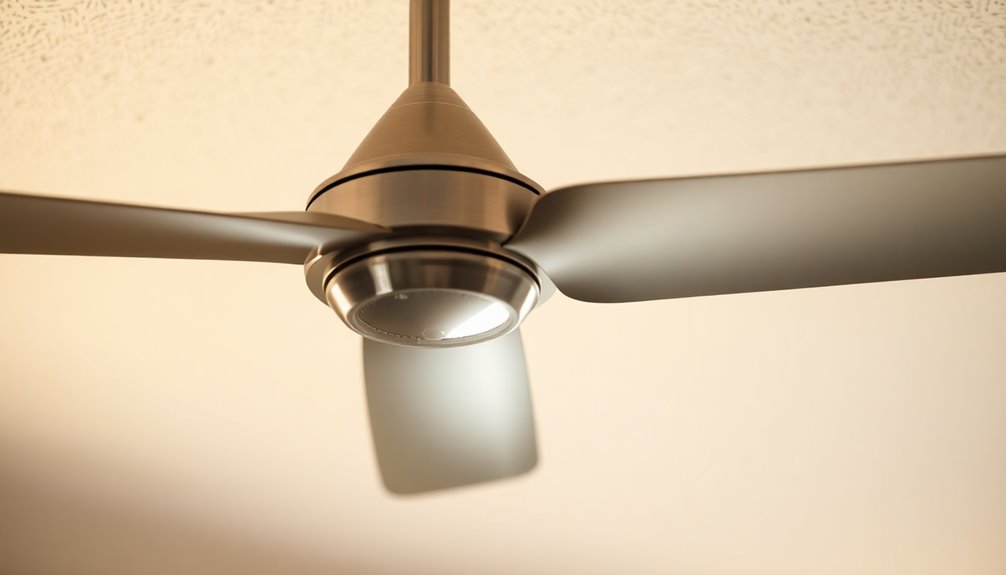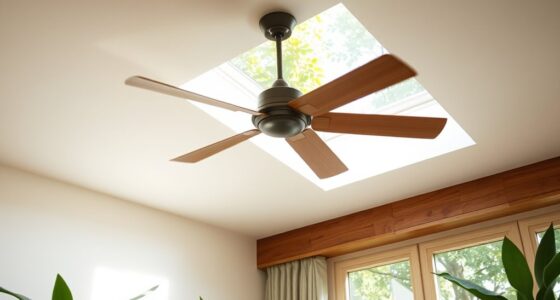If your ceiling fan's making a clicking noise, it's often due to loose blades or blade holder screws. Unbalanced blades can exacerbate the problem, leading to more vibrations. Check for foreign objects, like dust, that could disrupt movement. Loose screws in light fixtures might also contribute to the clicking sound. Additionally, electrical issues such as loose wiring can pose safety risks and lead to ongoing noise. Regular maintenance, like tightening screws and cleaning, is essential for preventing noise and prolonging your fan's lifespan. Discovering how to address these issues can help silence your fan effectively.
Key Takeaways
- Loose blades or blade holder screws can cause vibrations, leading to clicking noises when the fan is in operation.
- Unbalanced blades create mechanical strain, which can result in persistent clicking sounds during use.
- Foreign objects such as dust or debris may disrupt blade movement, causing clicking noises while the fan is running.
- Electrical issues, like loose wiring, can contribute to clicking sounds and pose safety risks if not addressed.
- Improper installation or misaligned blade holders can lead to noise, requiring adjustments for optimal performance.
Understanding Ceiling Fan Noises

When you hear clicking noises from your ceiling fan, it's crucial to understand what might be causing them. Often, these sounds stem from loose blades or blade holder screws, which create vibrations during operation.
If your fan blades are unbalanced, they can also lead to this clicking noise, causing mechanical strain that may worsen over time.
Another potential culprit could be electrical issues, such as loose wiring or connections within the fan. It's crucial to inspect these components thoroughly, as they can't only contribute to the clicking sound but may also pose safety risks.
Regular maintenance is key in preventing these problems. By routinely tightening screws and cleaning the fan, you can help maintain balance and functionality, reducing the likelihood of those annoying clicking noises.
If you've tried some DIY fixes and the clicking persists, it might be time to call in a professional. They can provide a proper assessment, ensuring your ceiling fan operates safely and efficiently.
Understanding these possible causes allows you to take the necessary steps to address the issue effectively, keeping your home peaceful and comfortable.
Common Causes of Clicking Noises

A ceiling fan can produce clicking noises for several common reasons that are often easy to identify. One of the most frequent culprits is loose blades or blade holder screws. When these screws aren't tightened properly, the blades can wobble and create vibrations, leading to those annoying clicking sounds.
If your fan's been improperly installed, misaligned blade holders can cause the blades to rub against the motor housing, producing similar noises.
Foreign objects can also disrupt the smooth movement of the blades. Dust or debris caught in the fan can result in clicking as the blades rotate. Regular maintenance is essential to prevent these sounds. By checking for loose screws and ensuring blades are correctly aligned, you can minimize the risk of clicking noises.
If you notice your ceiling fan making these sounds, it's important to address them promptly. Ignoring the issue can lead to further damage or even more disruptive noises in the future.
Taking the time for a quick inspection can save you from a headache later on.
Inspecting Your Ceiling Fan

When inspecting your ceiling fan, start by checking the tightness of the blades to guarantee they're secure.
Loose blades can cause clicking noises, so make sure all screws are tight.
Don't forget to examine the wiring connections as well, as any loose or damaged wires could contribute to the issue.
Check Blade Tightness
Making certain your ceiling fan operates smoothly often starts with checking blade tightness. If you hear clicking noises, loose blade screws or blade holders might be to blame.
Begin by inspecting each blade to see if the screws are tight. Loosening can lead to instability during operation, which not only creates annoying sounds but can also damage the fan over time.
While tightening the blade screws, be careful not to overtighten. Over-tightening can bend the blades, resulting in further balance issues and more clicking noises.
Additionally, take a moment to inspect for any warped or damaged blades. If you spot any issues, replacing those blades promptly is essential for maintaining peak performance.
Regular checks of blade tightness are part of proper maintenance for your ceiling fan. By making it a habit to inspect and tighten the screws as needed, you can prevent recurring clicking noises.
This simple step not only enhances the fan's longevity but also guarantees a quieter and more efficient operation. So, grab your tools and keep your ceiling fan in top shape!
Examine Wiring Connections
Inspecting your ceiling fan's wiring connections is important for eliminating clicking noises and guaranteeing safe operation. Start by turning off the power at the circuit breaker to avoid any electrical hazards while you work.
Carefully inspect wiring for any loose or damaged connections that might be causing intermittent clicking noises. Check all wire nuts to verify they're securely fastened; loose connections can lead to arcing or shorts, creating more unwelcome sounds.
Look for any signs of wear or fraying in the wiring insulation, as this can indicate potential hazards and contribute to unusual noises. Also, confirm that the fan's wiring is properly connected to the ceiling box.
A secure mounting bracket is essential, as vibrations from a poorly mounted fan can induce clicking noises.
Once you've completed your inspection, reassemble everything carefully and turn the power back on. If the clicking persists after addressing these wiring issues, it may be time to consult a professional electrician.
Tightening Loose Components

Tightening loose components on your ceiling fan can often eliminate annoying clicking noises. One common culprit is loose screws on the fan blades or blade holders. By systematically tightening the screws, you can resolve the issue quickly and efficiently.
Make it a part of your regular maintenance routine to check all visible screws and fasteners. This simple step can help prevent the recurrence of ceiling fan noises.
When tightening the screws, focus not only on the blade arms but also on other components, like the light fixtures and canopy. Ensuring these elements are secure enhances the fan's overall stability and performance.
However, be cautious not to overtighten, as this can lead to bending or damage. Just tighten the screws enough to secure them without applying excessive force.
Checking Fan Blade Alignment

When checking for clicking noises, start by inspecting the positioning of your fan blades.
Make sure they're level and parallel, as any misalignment can lead to unwanted sounds.
If you notice any discrepancies, adjust them carefully to eliminate the noise and keep your fan running smoothly.
Inspect Blade Positioning
Proper alignment of your ceiling fan blades is essential for smooth operation and minimizing noise. If your fan blades are misaligned, they can create clicking noises by coming into contact with other components or the fan housing during operation. To prevent this, you should regularly inspect the positioning of the blades. Look for any visible deviations in spacing and verify that they're parallel to one another.
If you notice a blade that seems out of alignment, gently adjust it to match the others, keeping them level to avoid noise. Using a level tool can be very helpful in verifying proper alignment, as even slight deviations can lead to excessive vibration and unwanted sounds.
Additionally, consult your ceiling fan's installation manual for specific guidance on blade alignment, as different models may have unique requirements for ideal positioning.
Adjust Alignment Carefully
How can you assure your ceiling fan blades are perfectly aligned? Start by inspecting each blade to verify they're all positioned at the same height and parallel to the ceiling. Misalignment often happens due to loose screws or improper installation, leading to those annoying clicking noises during operation.
To assess alignment, use a level to check the horizontal position of the fan blades. If you notice any discrepancies, it's time to adjust alignment carefully. Loosen any screws slightly, reposition the blades, and then retighten the screws to secure their new position.
Additionally, inspect each blade for any warping or bending. Damaged blades can disrupt balance and contribute to unwanted sounds, so it's essential to address these issues promptly.
Regularly checking and adjusting blade alignment not only minimizes noise but also prolongs the lifespan of your fan and enhances its overall performance.
Examining Light Fixtures

Many homeowners overlook the importance of examining light fixtures connected to ceiling fans, yet addressing potential issues can greatly reduce unwanted clicking noises. The clicking sounds you hear might stem from loose screws or fasteners in the light fixture. These loose components can cause vibrations during operation, creating a noisy ceiling fan.
To tackle this, start by carefully checking the light kit for any visibly loose components. If you spot any, tighten the screws to secure everything in place. Removing the globe or shade can give you better access to inspect and confirm the light fixture is snug. This simple action can prevent rattling sounds that contribute to the clicking noise.
Additionally, make certain the light bulbs are properly seated and not touching any part of the fixture, as this contact can also produce clicking noises. Regular maintenance, including inspecting and tightening the light fixtures, plays an essential role in preventing noise issues and extending the lifespan of both the fan and its lighting components. By taking these steps, you can enjoy a quieter and more efficient ceiling fan experience.
Moreover, ensuring that all components are securely attached can enhance the overall performance of the fan, similar to how best home security systems improve household safety through reliable installation.
Addressing Electrical Issues

Electrical issues can often be the root cause of clicking noises in your ceiling fan, and addressing them is vital for safe operation.
Start by inspecting for loose wiring connections, as these can lead to intermittent clicking sounds. If you notice any signs of damaged wiring or burning, it's critical to act quickly. Such symptoms may indicate serious electrical problems that could pose a fire hazard.
If your fan is controlled by a dimmer switch or an incompatible speed control, it might also produce clicking noises due to electrical pulses affecting its operation.
To further diagnose the issue, use a voltage tester to check the power supply to the fan. This tool can help you identify any inconsistencies that might be contributing to the noise.
However, if you're uncomfortable handling electrical components, it's always best to consult a qualified electrician. They can accurately diagnose and repair any underlying electrical issues, guaranteeing your ceiling fan operates smoothly and without noise.
Don't ignore clicking noises; addressing these electrical issues promptly can prevent further complications and safeguard your safety.
Preventive Maintenance Tips

To keep your ceiling fan running smoothly and quietly, regular preventive maintenance is essential. Neglecting this can lead to annoying clicking noises caused by loose components or dirt buildup.
Here are four maintenance tips to help you avoid these issues:
- Inspect screws and fasteners: Regularly check all screws on the fan blades and light fixtures. Tighten any loose screws to prevent unwanted noise during operation.
- Clean the blades and housing: Dust and debris can accumulate over time, leading to imbalance and noise. Wipe down the blades and housing periodically to maintain peak performance and ensure that your fan operates efficiently, similar to how HEPA filtration enhances air quality. Regular cleaning can also help prevent the accumulation of allergens, similar to the way air purifiers work.
- Lubricate the motor and bearings: Follow the manufacturer's recommendations for lubricating the fan motor and bearings. Proper lubrication reduces friction, which can contribute to mechanical noises, including clicking.
- Check installation and alignment: Verify that your fan is properly installed and aligned. Misalignment can cause mechanical interference, leading to annoying clicking sounds. Regular maintenance can enhance the efficiency of the refrigeration cycle by up to 70%.
When to Seek Professional Help

Sometimes, the peace of mind that comes from knowing when to seek professional help can save you from further complications with your ceiling fan. If you've tightened all screws and the clicking noises persist, it might signal a deeper mechanical issue that requires expert diagnostics.
It's vital not to ignore these sounds, especially if they're accompanied by unusual vibrations or changes in fan speed. In these cases, it's wise to consult a professional to prevent potential damage to the fan motor.
If you notice the clicking noise is linked with electrical issues, like flickering lights or buzzing sounds, don't hesitate to reach out to a qualified electrician. Your safety is paramount, and they can help resolve these problems effectively.
For older fans or those that haven't undergone regular maintenance, a professional evaluation is necessary. This assessment can reveal whether repairs or replacement are necessary for peak performance.
Frequently Asked Questions
How Do I Stop My Ceiling Fan From Clicking?
To stop your ceiling fan from clicking, start by inspecting all screws on the fan blades and blade holder.
Tighten any loose screws you find. Next, check for debris or foreign objects that might be obstructing the blades.
Verify the blades are aligned correctly and free from warping. Finally, examine the light fixture for loose fittings.
Regular maintenance and cleaning will also help keep everything running smoothly and minimize those annoying clicking sounds.
Why Does My Ceiling Make a Clicking Sound?
If your ceiling's making a clicking sound, it might be due to loose parts or an issue with the structure itself.
You should check for any objects that may be causing the noise, like loose tiles or light fixtures.
Inspecting the area for debris or misalignment can help you pinpoint the problem.
If the noise persists, consider consulting a professional to verify everything's secure and functioning properly.
Should I Be Worried if My Ceiling Fan Is Making Noise?
If your ceiling fan's making noise, it's natural to feel concerned. You should investigate it promptly, as ignoring the sound could lead to bigger problems later.
Check for loose blades or screws; tightening them might resolve the issue. If the noise persists, consider that it could indicate an unbalanced fan, which may wear out the motor.
Don't hesitate to consult a professional if you're unsure; it could save you time and money.
Why Does My Standing Fan Make a Clicking Sound?
If your standing fan's making a clicking sound, it could be due to loose screws or components that need tightening.
Check for any foreign objects caught in the blades, as dust or debris can cause noise.
Misaligned or bent blades might also create that annoying clicking.
Finally, consider potential electrical issues.
Regular maintenance, like cleaning and tightening parts, can help prevent these noises and keep your fan running smoothly.
Conclusion
To sum up, if your ceiling fan's making a clicking noise, don't ignore it. Addressing these issues early can prevent more significant problems down the line. Did you know that nearly 50% of ceiling fan issues stem from loose components? By regularly inspecting and tightening your fan, you can extend its lifespan and keep your home comfortable. So, take the time to maintain your fan, and enjoy a quieter, smoother operation!









